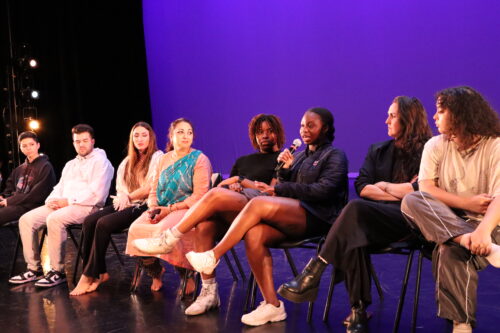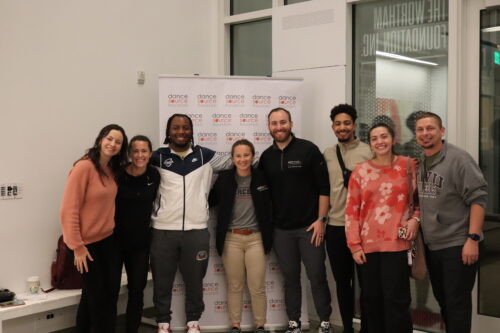Dancers and Physical Therapists in Conversation: New Initiative at Dance Source Houston Opens Dialog

Dancers are no strangers to injuries. When the injury is bad enough and the dancer has enough money, they might go see a physical therapist. In that visit, the dancer is looking for advice and help. On November 14, 2023, Dance Source Houston (DSH) sought to turn that relationship into a more mutual one with their first edition of the Physical Therapy Dance Exchange.
DSH, a dance service organization, first entered the realm of dancer health in 2017 with their first Day of Dancer Health. The 2017 International Association for Dance Medicine and Science (IADMS) annual conference was held in Houston and the enthusiasm from Houston therapists who attended it led to that first Day of Dancer Health. The event was modeled on a program by the same name put on by the Dance Resource Center in Los Angeles, using a screening tool developed by medical professionals from Dance/USA’s Task Force on Dancer Health. The next Houston Day of Dancer Health was held in 2019, and has become an annual event since 2021. (The next one is scheduled for December 7. Registration is full but visit the DSH website to get on the wait list.)
In 2018, the physical therapy department at Memorial Hermann reached out to DSH about supporting the dance community, particularly through their PT residency program. This led to DSH’s monthly Dancer Physical Therapy Clinic, where dancers can get free, 30-minute PT evaluations. The dancers obviously benefit from the therapy but the residents also benefit. “They get a lot of experience with sports athletes,” Mollie Haven Miller, DSH Executive Director, said. “But here they get to work with a different population of specialized movers.”
Hallie Ward Kou, a physical therapist with Memorial Hermann’s Rockets Sports Medicine Institute, has been working with DSH’s dancer health initiatives since 2020. She says, “We’ve been brainstorming ways for the physical therapists that see the dancers through these programs to better understand their needs and the nuances that come with these athletes.” She credits Haven Miller, and Brittany Bass, DSH Programs Manager, with the idea for the Physical Therapy Dance Exchange. “When Mollie and Brittany proposed this idea to us I was thrilled.”
This first Physical Therapy Dance Exchange followed a lecture-demonstration format, with eight different dance styles presented by experts in each style. The program included:
Aerial (Lecture by Toni Leago Valle, performance by Michelle Reyes)
Afrodance (Lecture by Kemi OG, performance by Chichi Aladume and Kemi OG
Ballet (Presented by Mollie Haven Miller for Melody Mennite, who was unable to attend)
Breaking (Lecture by Joel Aguilera, performance by Joel Aguilera and Jeffrey Louis
Contemporary/Modern (Lecture by Alisa Mittin, performance by Amanda Monteith
Flamenco (Lecture and performance by Jessica Figueroa)
Kathak (Lecture and performance by Kalpana Subbara)
Tap (Lecture and performance by Dorena Battaglino




Each lecture gave a brief history of the form, how it originated and developed. They talked about the training, the frequency and duration of it, and where it takes place (not all dance training takes place in a studio). They talked about ideal situations for a performance but also the reality that they may be performing in environments not specifically made for dance. Most importantly for this setting they discussed where their form stressed the dancer’s body and where the dancers most often suffer injury. Aerial dancers, for example, experience frequent rotator cuff injuries while breakdancers report wrist injuries. Of course, some injuries occurred across the dance styles. In the question-and-answer period session at the end of the evening, the 10 presenters on stage were asked who among them had experiences plantar fasciitis. Seven raised their hands, only four of whom sought professional help to treat the condition.
Some forms have specialized equipment or accessories. Ballet, Flamenco, and Tap all have form-specific shoes. Kathak utilizes ankle bracelets (Ghunghroos) that will have 100-300 bells on each leg, which can weigh one to four pounds. Aerial, of course, uses trapeze, silks, and other hanging apparatus. Each of these accessories supports the dance and offers opportunities for injury.
The evening presented quite a lot of information in the more than 90 minutes it took to present the eight styles. “My favorite part of it,” Haven Miller said after the event, “was just being able to put those eight individuals forward as experts in their field in front of other experts.”


There was about 20 minutes available for the PT audience members to ask questions of the presenters. Besides the previously noted question about plantar fasciitis, the therapists wanted to know how to talk to dancers. For example, if a dancer is going to continue dancing through recovery from an injury what sort of home exercise program would a dancer be able to keep doing around classes and other training? Amanda Montieth noted, “I’m more likely to do it if I feel like it’s directly applicable to stuff I’m doing already. So if it feels like a complex movement, I think I find it more feasible to continue.” The sentiment of having a regimen that wasn’t too easy was repeated by other dancers.
Another question was about the least and most helpful conversations dancers have had with medical professionals. Most agreed that the advice to stop dancing was not feasible. “We know that if we stopped, we’d heal faster,” Dorena Battaglino acknowledged, “but we need you to work with us on what we can do.” The nature of a dancer’s life is that there is no paid time off and no dancing equals no income. Some asked for help to get through an immediate performance and then they could discuss a regimen that included more rest.
Chichi Aladume gave an anecdote of a doctor who prescribed pain medicines. “I want to fix the problem,” she said, “I don’t want to just take meds.”
On another note, Kalpana Subbarao relayed a story of a therapist relieving her fears. She had torn a muscle below her knee and she was worried that some of the choreography she was doing caused the injury but the therapist told her that was unlikely, that it was more likely that muscles that weren’t being used as much resulted in the tear. “It was reassuring that what I’m doing with my dancing is not actually hurting but that something else caused the tear.” That therapist gave her exercises to work smaller, supporting muscle groups.
Among other pieces of information the dancers shared, Joel Aquilera noted that most dancers have video of their rehearsals and performances and can, in many cases, show a therapist exactly what they were doing when they got hurt. Michelle Reyes noted that the dance community shares information. If one goes to a PT and gets some targeted exercises, those exercises will be shared with other dancers.
Toni Leago Valle noted that most dancers have some knowledge of physiology, kinesiology, or biomechanics. “I’m very much wanting to know the term,” she said. “I will go home and pull out my kinesiology book and look exactly where that muscle is and figure out where its origin of insertion is and work that muscle.”

Thinking about the event a week later, Hallie Ward Kou, who has a dance background in addition to being a PT, was enthusiastic about the evening. “The clinicians and student physical therapists in the audience who are not dancers came away from the event with an excited and new appreciation for dance thanks to the incredible work and presentation by the artists,” she said. “The intimacy of this event helped foster some really meaningful, up-close observation and discussion between dancers and clinicians. The demands of dance, and especially specific demands for each type of dance, can be easily overlooked in healthcare by those who aren’t able to dig deep and ask the appropriate questions. This event gave so many clinicians an incredible tool to use as they move forward in their careers to help give the best physical therapy care to dancers.”
Haven Miller expects this to be only the first of this type of event for DSH, and stated that it appears to be the first of its kind to be offered by a local dance support organization. It adds another dimension to the dance health and wellness programs already offered by DSH.
Dance Source Houston Health & Wellness Initiative Programs
Dancer Physical Therapy Clinic
Dancer Wellness Series
Day of Dancer Health
Physical Therapy Dance Exchange
The Dancer Health & Wellness Initiative Programs are made possible through support from the Houston Mayor’s Office of Cultural Affairs, Mid America Arts Alliance and Texas Commission on the Arts.



Recent Comments